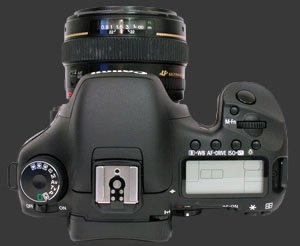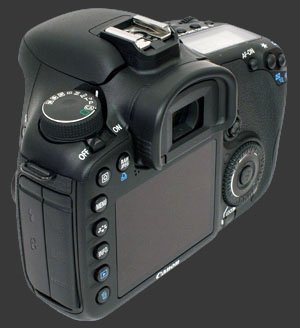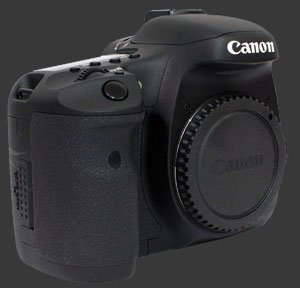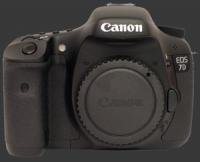Canon EOS 7D Review
Canon EOS 7D Performance - How well does it take pictures?
Ultimately, it is the image quality that makes a camera worth buying. For a digital SLR, image quality greatly depends on the lens used. While color, noise, contrast and exposure are properties of the camera, distortion, vignetting and chromatic aberrations are properties of the lens. Sharpness depends on the weakest link. So, the camera cannot capture more details than the lens lets through. Conversely, it is possible for a lens to transmit more details than the sensor can capture.
In terms of image noise, the Canon 7D excels. At 18 MP, it still manages to keep noise exceptionally low and capture images with a good amount of details. Images are noise-free up to ISO 400 with the slightest hint appearing at ISO 800. ISO 1600 shows a small reduction in sharpness but is still very usable. ISO 3200 takes this further but can pull off a mid-sized print without problems. Even ISO 6400 and 12800 are usable for smaller prints. This is a superb performance compared to other cropped-sensor DSLRs.
Image quality is not only about noise though. Exposure is metered using one of 4 patterns. Spot and partial behave exactly as expected. Center-weighed is reasonable but is subject to the usual overexposure when the background is brighter than the center of the frame. This is the reason multi-segment metering was invented. Unfortunately, the Canon 7D's new metering is overly influenced by the point of focus. Most bright backgrounds become over-exposed in an effort to keep the subject bright. Typically, the Canon 7D overexposes by ½ EV but it too frequently does so by more, up to 3½ EV at times. It does not help that the LCD is overexposed by default but after closer inspection, this DSLR still burns highlights 5% of the time. This is higher than recently tested DSLRs other than the Nikon D60. A firmware fix could certainly fix this, but at the moment the evaluative metering system is not working out.

The other weak spot of the Canon EOS 7D is its color-rendition. It is impossible to make it output reasonably accurate colors. One could profile the camera and create an ICC profile for RAW conversion, but JPEG users are at a loss. Now, colors are not completely wrong but there is more deviation than usual for a digital camera, DSLR or not. The difference, regardless of image parameters, is complex as well, so its not simply a matter of adjusting saturation or shifting hue. There are hue and saturation shifts in varying amounts depending on the color.
Auto while-balance is quite good in natural light but kind of poor under artificial light. The custom white-balance setting though is perfect. This performance is typical for most DSLR cameras, probably because there is much color variation among artificial lighting and sampling a small number of points in the scene does not provide a high enough level of confidence. Compacts cameras do better because they can read the whole sensor to make a better estimation of white-balance. Conceivably a DSLR could do the same in Live-View.
Sharpness is controlled in 8 steps going from very soft to quite sharpened but with relatively low artifacts. The default is sharper than most DSLRs but that is just the default. A few artifacts can be seen at mid-level but they are minor. Even increasing sharpness to the max does not increase sharpening artifacts by much. They are present but only along edges of very high contrast. Remember that image sharpness depends on the lens as well as the camera.
Canon EOS 7D Speed - How fast does it take pictures?
The new autofocus system is extremely reliable. It rarely misses. In continuous mode it keeps up well with moving subjects and camera motion. Locking focus is super-fast. The camera highlights all focus points that achieve focus. Naturally, focus speeds can be impacted by the lens.
DSLR speed has been improving every year and this time is no exception, the Canon EOS 7D is among the fastest digital cameras. Power off to on is instantaneous and off to the first shot taken can happen in less than 1s. Using manual focus, this can be under 1/3s. That is really nice!
Shutter-lag is virtually inexistent, as is blackout time. It is so fast, the viewfinder does not seem to go black, only dim a little for a fraction of a second. Shot-to-shot speed, the second most important timing after shutter-lag, is fast. It is limited mostly by the time to focus. In manual focus, it is less than ¼s.
The continuous drive is exceptionally fast at 8 FPS. It can also sustain this for really long bursts, up to 126 images. Using manual focus, the 7D can always its advertised 8 FPS. Given that autofocus may take more than 1/8s, it can happen that continuous shooting slows down. The same is obviously true for low-light photography.
Controls are extremely responsive and most give nearly instant feedback. The time to go from a shot to its preview is just over 1s, which is the only less than excellent timing for the 7D. When the preview appears, one cannot zoom in through. For that, Playback mode must be used. This is about 1s away after pressing the Play button. In Playback mode, cycling between image information is quick but it gets a little long to go through all the screens to go back. Since many buttons are left unused in this mode, it would be nice to have one that pops up a histogram and lets it go when the button is released.
Going back from Playback mode to Shooting mode is very quick, under ¼s. Turning the camera off takes at least 3s. The sensor cleaning takes the most part of this with extra time taken to flush the internal buffer as needed.
Live-view has multiple autofocus modes. Contrast-detect was found to be relatively fast. Most times, it takes under 1s to lock focus. In good light, it is even ½s or less. Under low-light it can take between 1-2s. Still, this is faster than most DSLRs in Live-View mode.
The built-in flash is quite powerful and cycles very fast. Even enough for short bursts of continuous shooting, 2 to 4 images, depending on flash strength.

Canon EOS 7D Performance - How well does it shoot movies?
The 7D is Canon's 4th camera to feature movie-recording capabilities. It is still primarily designed as a still camera. Photography comes first and video next.
At its maximum video resolution, this model can shoot at 1080p which is the highest HDTV resolution. It can do so at 30, 25 or 24 FPS. The convenience of these different frame rate depends on the intended output medium. A 30 FPS rate is typical for North American television, while 25 FPS is typical in Europe. 24 FPS is more cinematic. The 7D can also record 720p video at 60 and 50 FPS. This is better suited for action because it gives more fluid motion.
Its movie-mode switch which is independent from the mode-dial allows for extremely flexible shooting. ISO can be automatically or manual set, between 100 and 6400. Aperture and shutter-speed are controlled depending on the exposure mode. Autofocus uses contrast-detection, the same as the live-view system.
Video quality is very good, outputting low noise vide as it does for stills. Compression uses MPEG-4 somewhat aggressively which shows up as motion artifacts during quick panning. Slow movements are no problem. Video frames are very sharp, which seems due to how the EOS 7D reads its pixels for video-recording, rather than image processing.
The advantage of a relatively large sensor gives optionally shallow-depth of field and having interchangeable lens gives a lot of flexibility. The downside is that a DSLR body and lens, designed with still images in mind, is harder to use as a video camera. The main issue is steadiness which is hard to achieve for more than a few seconds while holding the camera away from your body. Video cameras have electronic viewfinders (EVF) that keep the camera against your eye while shooting. This is not the case with a DSLR because video is implemented as part of live-view which shows on the rear LCD since there is no EVF on such cameras.

Canon EOS 7D Conclusion
The Canon EOS 7D is an incredibly versatile camera. Its rich feature set make it one of the most complete DSLRs available. Given its high-resolution sensor, wide range of ISO sensitivities, high-speed continuous drive, there is no subject too difficult for it. Its durable and weather-sealed body can be taken to more places than most DSLRs.
Not only that, the 7D helps photographers by providing a 100% coverage viewfinder and built-in digital level, letting him compose and frame with greater ease. The camera's design provides a very secure hold with good - although not ideal - access to important features. There is also one of the most flexible movie-recording mode of any DSLR to complete this impressive package.
Those two previous paragraphs are why it is hard to write the conclusion for this review. This camera does so much that one wants to use it. In the end what counts though is results. The Canon 7D delivers on multiple fronts. All that has to do with speed and autofocus is fantastic. This SLR is blazing fast and always responds quickly.
Image quality when it comes to noise is awesome. This 18 megapixels camera produces clear results up to ISO 1600, perfectly usable for large prints and even remains usable to ISO 12,800 for smaller prints. While-balance is very good except under artificial light. This is typical and not much of a problem because custom white-balance is right on.
Where the 7D unfortunately falls down is in terms of color and exposure. One can obtain any color desired from a RAW file, so RAW-shooters need not worry about color problems. In JPEG though the review unit did not manage to produce colors of reasonable accuracy, regardless of settings used. Hue variation was all over the place, some colors remained the same but others changed enough to be called by another name. Note that although we had a production Canon EOS 7D, the firmware has changed twice since then.
In terms of exposure, the new metering system produces more over-exposure than most DSLRs. It depends on the circumstances but for it is too inconsistent to be ignored. One cannot be expected to check the histogram between every shot either. Center weighed metering can be used instead but that too fails, albeit in a more predicable way. These are the only two problems with the 7D but those are enough to miss the top rating.
Those shooting RAW who can live avoiding the evaluative metering system, can consider this an Excellent camera. For the rest, one can hope that Canon fixes these issues with a new firmware, which should be possible given the hardware seems really good and these issues stem from internal calculations.
 |
Please Support Neocamera
All information on Neocamera is provided free of charge yet running this website is a huge endeavor. Purchases made via affiliate links found throughout the site help keep it running and up-to-date. There is no additional cost to you, so please consider buying via these links to our affilates:
Thank you for your support!
Canon 7D Highlights

Sensor-Size: 22 x 15mm

Actual size when viewed at 100 DPI
| 18 Megapixels DSLR | ISO 100-12800 |
| Canon EF Mount 1.6X FLM | Shutter 1/8000-30s |
| 100% Coverage Large Viewfinder | Full manual controls, including Manual Focus |
| 2 Axis Digital Level | Custom white-balance with 2 axis fine-tuning |
| Weatherproof | Spot-Metering |
| Built-in Dust Reduction | Hot-Shoe & Sync-Port |
| 8 FPS Drive, 126 Images | Stereo audio input |
| 1920x1080 @ 30 FPS Video Recording | Lithium-Ion Battery |
| 3" LCD 920K Pixels | Compact Flash |
Updates
2025.11.13

Best Gifts for Photographers in 2025 by Budget
The annual Neocamera Photography Gift Guide updated to 2025. Find great gifts for photographers with any price budget.
2025.07.07

Stellar Photo Recovery Review
Review of Stellar Photo Recovery V12. This Windows and MacOS software can recover photos and videos in a huge number of formats from memory cards, USB drives, SSDs and HHDs.
2025.05.14

Huion Kamvas 13 Gen 3 Review
In-Depth review of the Huion Kamvas 13 Gen 3 Pen Display Tablet for photographers and graphic artists.
2025.01.18

Fujifilm GFX 2025 Lens Roundup
Lens Review roundup of Fujifilm GFX Medium-Format lenses. Quality, performance and handling of the GF20-35mm F/4R WR, GF30mm F/3.5 Tilt-Shift and the GF55mm F/1.7.
2024.11.18

Best 2024 Photography Gifts for Every Budget
Great gifts for photographers and photo enthusiasts selected for every budget among the best products of 2024.
2024.08.07

Eye Protection Tips for Professional Photographers
The four main considerations for professional photographers regarding eyewear.
2024.07.14

Fujifilm X100VI Review
Flagship fixed-lens compact digital camera with a 40 MP sensor and Image-Stabilization, a first for the series. Retro design featuring dual control-dials, plus direct ISO, Shutter-Speed and EC dials. Its hybrid viewfinder can switch between EVF and OVF mode.
2024.05.09

Fujifilm GFX100 II Review
Flagship 102 Megapixels Medium-Format Mirrorless Digital Camera with 8-Stop 5-Axis IBIS, 8 FPS Drive, 8K Video and 400 MP Super-Resolution capture in a weatherproof and freezeproof body with dual control-dials and dual memory-card slots.
2024.04.03

Fujifilm X-T5 Review
Newest Fujifilm flagship boasting a 40 MP APS-C sensor, 5-axis IBIS with 7-stop efficiency, 15 FPS continuous drive, 6.2K Video capture, dual control-dials and dual SDXC UHS-II slots in a sturdy weatherproof and freezeproof body.
2023.11.20

Best Digital Cameras of 2023
Find out which are the Best Digital Cameras of 2023. All the new Mirrorless Digital Cameras from entry-level to high-end professional.
2023.07.10

Fujifilm X-H2 Review
40 Megapixels APS-C Hybrid Mirrorless Digital Camera with 7-stop IBIS. Fastest shutter ever and 8K video capture. Large builtin EVF with 0.8X magnification and 5.8 MP, plus an Eye-Start Sensor. Packed with features and large number of controls in a weatherproof and freezeproof body.
2023.05.07

Sony FE 20-70mm F/4G Review
Review of the unique Sony FE 20-70mm F/4G lens. The optical zoom of this lens spans ultra-wide-angle and medium focal-length coverage, making it one of the most versatile Full-Frame lenses on the market.










